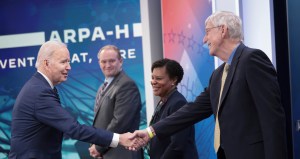Five tech projects buried in the budget

Data mining jobs data. Testing self-driving car testing. Tailoring medical treatments.
Tucked away in the White House’s budget request released Tuesday are billions of dollars’ worth of projects that advance technology — or that use it to further an agency’s objectives.
There’s no guarantee that President Barack Obama’s $4.1 trillion budget proposal, the last of his presidency, will clear Congress. In fact, Republican congressional leaders have said it’s dead on arrival.
But even if the budget as a whole is DOA, many line items will survive. Here’s a look at a few tech-related projects the budget would support:
Anti-encryption research funding
The FBI has asked for an additional $38.3 million this year to fund anti-encryption technology and research — more than doubling last year’s $31 million request to nearly $70 million.
In a summary of its budget request, the agency said the funding “will counter the threat of Going Dark, which includes the inability to access data because of challenges related to encryption, mobility, anonymization, and more.” The request said the agency would “develop and acquire tools for electronic device analysis, cryptanalytic capability, and forensic tools.”
Over the past year, the G-men have taken a strong stance in the encryption debate. Last summer, FBI Director James Comey testified before Congress that companies that produce communications platforms should offer a “backdoor” to police and other law enforcement agents who want access to the digital communications of criminals.
Opponents to such a policy argue that creating a “backdoor” compromises the security of the system itself, providing a vulnerability that others can exploit.
Putting job market data to work
The White House wants to tap data on training programs and labor market trends to help people get jobs. It pitches investing $500 million over five years in a Workforce Data Science and Innovation Fund, which would focus on improving the quality and management of existing workforce data workforce data, and creating tools to use it.
The money would go toward helping develop open source data analytics tools, standard data exchange formats and database architectures to better analyze fiscal and case management data. Through the fund, officials also would establish a Center of Excellence for labor market data science and development services.
“By creating new data standards, analytical datasets, and open data products, the government will be creating a resource for researchers, developers, and entrepreneurs to develop applications and services to support the American workers,” said a budget overview from the Labor Department.
One of the fund’s first jobs? To help develop state-based Eligible Training Provider Scorecards. Similar to the U.S. Digital Services’ College Scorecard project, these workforce training provider scorecards would publish outcome metrics for federally funded training programs.
Turning the ignition on self-driving cars?
The Obama administration wants to see how self-driving cars and trucks would fare on the road. Buried in the Department of Transportation budget is a program to spend nearly $3.9 billion over 10 years to pilot “safe and climate-smart autonomous vehicles.”
“To accelerate the development and adoption of autonomous vehicles, this program would fund large-scale deployment pilots to test connected vehicle systems in designated corridors throughout the country; and work with industry to ensure a common multi-state interoperability framework for connected and autonomous vehicles,” the DOT budget factsheet says.
Transportation Secretary Anthony Foxx alluded to these plans last month during the North American International Auto Show in Detroit.
Promoting body-worn cameras
The budget includes $20 million for the Office of Justice Programs’ Smart Policing Program — representing a $15 million increase in the programs’ funding. Of that, $10 million will be used for a Body Worn Camera Problem-Solving Demonstration Program, which aims to promote the use of the devices “as a key component of comprehensive, community-based problem solving strategies,” according to a Justice Department budget summary.
At the same time, it would increase funding for the Body Worn Camera Partnership Program to $30 million. The program, which last fiscal year was funded at $22.5 million, provides matching grants to state, local, and tribal governments that cover up to half of the cost of purchasing body worn cameras.
“Evidence indicates that the presence of body-worn cameras can assist in de-escalating conflicts, resulting in more constructive encounters between the police and members of the community,” the office’s budget summary says. “While this is a technology-based program, grantees will be encouraged to commit to a comprehensive problem solving strategy for their BWC programs that will contribute to improvements in relations between law enforcement and the community.”
Tailoring medical treatments
The White House asked Congress for $309 million to continue support for its work in precision medicine — the philosophy that doctors could tailor treatments based on a patient’s genetics, environment and lifestyle.
According to a budget summary, most of the money would go to the National Institutes of Health to support efforts now underway to establish a 1 million-person research cohort.
“Research based on this cohort will lay the foundation for findings for many diseases that can lead to new prevention strategies, novel therapeutics, and medical devices,” according to a Department of Health and Human Services budget summary.
The funding request would double the funding the Food and Drug Administration receives for its precision medicine efforts — from $2 million to $4.4 million. With this increase, FDA would create a National Medical Device Evaluation System to help find patients who would most benefit from using certain devices. It would also continue investing in precisionFDA, a platform that launched at the end of last year that allows researchers to share research on next-generation sequencing, an advanced technology that generates massive amounts of genetic data.
The president announced his Precision Medicine Initiative during his 2015 State of the Union Address. When federal Chief Data Scientist DJ Patil joined the government last year, officials said the initiative would be one of his priorities.
Editor’s Note: Owing to confusion on the part of an agency source, an earlier version of this story mistakenly reported that the fiscal year 17 request for Going Dark was $38.3 million in total.






